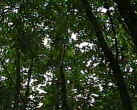On screen
Time
Description of Scene
Narrator

00:00:00
Title
Treetops down to soil
Today we are going to be investigating the soil which forms in a deciduous forest.
If you grew up around Paris, you know what a deciduous forest is. Here's what one looks like. It's a place where all the leaves fall in the winter.

00:01:00
close-up of forest floor
In this video, we will be asking ourselves two questions: What is soil and how is it made?

00:01:14
Label “What is Soil” on forest floor.
Label and leaves swept away to dig up some soil.
First of all, what is soil? What is it made of? What is in it?

00:01:38
Hand picking up soil
Well, let's have a look at it.
What do you think is in there?

00:01:50
00:01:58
A handful of soil on white paper.
One by one labels are put on
“ - rock”
First of all, there are particles of rock. These bring minerals to the soil

00:02:10
00:02:15
00:02:25
“ - organic material”
“ - H2O”
“ - air”
Secondly, there is organic material. Organic means something which was made by living organisms. This includes dead leaves, pieces of wood, etc.
You know there is water in soil. Water (also known as H2O) is necessary for all living organisms.
Between the particles of soil, there is air. This allows organisms such as earthworms to breathe.

00:02:40
00:02:57
zoom in on soil, then the label
“ - microscopic life”
is placed on top.
There is one more thing in soil which is extremely important: Life. And most of the living organisms in soil are too small to be seen - they are microscopic.
Why are they there? This leads us to the next question. How is soil made?

00:03:13
00:03:30
Label “How is Soil Made?”
Label “decay” placed on white sheet
One of the most important concepts to understand in order to answer that question is decay.
Let's see what happens during decay.

00:03:44
00:03:50
00:04:10
00:05:10
green leaf...
brown leaf...
torn leaf ... broken up leaf ... almost nothing left to leaf
finally, just particles, label decay” placed
Here is a living leaf. It is green and healthy.
When it dies, it turns brown and falls the forest floor. But it does not stay like that.
Watch what happens over many months.
Notice that the stem, which is the most rigid part of the leaf resists decay the longest. Slowly, over time, the leaf is reduced to powder.

00:05:27
00:05:33
Black soil
Label placed on top:
“ - microscopic life”
fade to black
Who is responsible for this decay? Who is eating these leaves and reducing them to powder? The answer is microscopic organisms living in the soil. In the laboratory, we will be doing several experiments to observe these incredible life forms.

00:05:55
00:06:45
after blackout, scene of the forest, use of an auger to take a sample
zoom in to see a close-up of the sample of soil in the auger
Let's see what happens to the soil as we go deeper into the ground.
To study soil, we use a tool called an auger to dig and collect samples. The auger is pushed and turned approximately 20 cm below the surface.
As we pull up the auger [pause if necessary to see close-up], we clearly see that the color of the soil changes as we go deeper.

00:07:06
00:07:10
00:07:20
00:07:30
00:07:40
sample on a white background; labels are added one by one:
“ - leaf litter”
“ - humus”
“ - mineral layer”
“ - bedrock layer”
There are different names for each of the layers we see.
The top layer, which we walk on in the forest, is called the leaf litter layer. It is made of broken bits of leaves and wood.
The very dark layer below that is called the humus layer. It is very rich in organic material.
The brown layer is called the mineral layer because it contains many minerals to help plants grow.
The bottom layer, which is a light sandy color, is the bedrock layer. It is made up essentially of bits of rock.
In almost all the experiments we do in the next few weeks, we will use each of these layers.
00:07:58
end 0:08:30
the forest
So next time you walk through the forest, remember that you are not alone. You are in the company of millions of organisms which are helping to make the soil under your feet. And remember that soil is not just dirt - it is a complex medium full of unseen wonders.